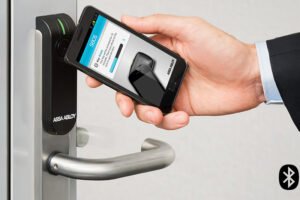With issues around climate change and ‘greener business’ always in the headlines, many organisations want to enhance their procedures. Security, facilities and building management teams can play a role — by switching access control to a wire-free solution. ASSA ABLOY Opening Solutions EMEIA Product Marketing Director, Thomas Schulz, provides a guide to wireless access control and how it can contribute to any organisation’s sustainability strategy.
In a survey for IFSEC Global’s “Wireless Access Control Report 2021”, 90% of industry professionals agreed sustainability would influence their future commissioning of security technology. In the mission to make buildings both “greener” and “smarter”, access control has a major role to play.
The importance of sustainability for access control
The UN Environment Programme estimates that buildings consume around 60% of the world’s electricity. It makes sense, then, that the World Green Building Council identifies energy efficiency as one essential feature in any “green building”. All technologies employed inside a building can help to reduce its footprint.
Motives for ‘greening’ buildings can also go beyond altruism. According to the Harvard Business Review, energy efficiency has become one of the “key levers for business success”. For property owners or developers, evidence suggests “green certification” for a building increases rental value by as much as 12%.
In environmental certification schemes such as LEED and BREEAM, energy efficiency is a key assessment criterion. Measurable improvements in energy performance can help ensure a new build or retrofit receives its desired award.
What is wireless access control and how does it work?
As filtering access to premises developed beyond lock-and-key technology, the first electronic solutions relied on cables. Despite being invasive and expensive to fit, these wired locks gave security and facility managers much greater control.
Door technology has now evolved further. The same features are available without the expense or intrusion of wires, as a new generation of wireless locks combines enhanced security with a leap forward in convenience and flexibility. Because they are faster and more cost-efficient to install, these wireless locks help facility managers extend control within their premises further than ever before.


 Wireless locks also work more efficiently. Instead of needing an ‘always on’ mains electricity connection to power their locking magnets, they only ‘wake up’ when presented with a credential. By deploying battery powered wireless locks, companies can expect significant energy savings during operation: more than
Wireless locks also work more efficiently. Instead of needing an ‘always on’ mains electricity connection to power their locking magnets, they only ‘wake up’ when presented with a credential. By deploying battery powered wireless locks, companies can expect significant energy savings during operation: more than 